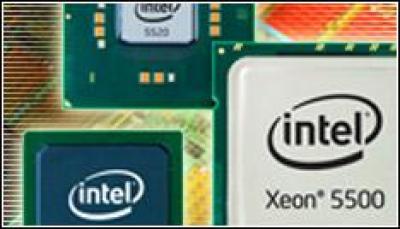Intel Posts Record Quarter From Xeon Demand

Intel has reported record financial numbers in the second quarter
Demand in both the corporate and consumer sectors helped Intel post a record fiscal quarter on 13 July, netting $2.9 billion (£1.9bn) on $10.8 billion in revenue in the second quarter.
Intel’s success had much to do with demand for servers and PCs powered by the company’s latest processors, in particular the 2010 Core i PC chips and 32-nanometer Xeon processors, according to CEO Paul Otellini. The company is also seeing a steady demand for its Atom chips, and expects to see the platform grow beyond the netbook space into handheld devices and the embedded space in 2011, he said.
Energy Efficiency
Otellini also said although corporate demand dropped significantly in 2009 due to the worldwide recession, businesses are now beginning to refresh their fleets of PCs and servers. By doing so they are looking to reduce the rising costs associated with older systems, to take advantage of the energy efficiency and performance gains of the newer chips, and to bring Windows 7 into their IT environments.
“In Q2, we saw the return of corporate purchases,” Otellini said in a conference call with reporters and analysts on 13 July. “The [older] machines were just costing more to keep on the books than they were worth.”
Intel’s server business was helped also by the growth of cloud computing environments. Revenue in Intel’s IP data center business grew 170 percent, Otellini said.
Intel saw overall revenue growth of 34 percent over the same period last year. The Data Center Group’s revenue grew 42 percent, and the PC Client Group had a revenue gain of 31 percent over the second quarter 2009.
Intel’s strong second quarter means good things for the industry, according to Technology Business Research analyst John Spooner.
“Intel’s ability to buck seasonality with its [second-quarter] earnings bodes well for the PC market as a whole,” Spooner said in a research note. “Intel’s double-digit year-to-year revenue growth reflects on strong processor and chip-set unit demand from manufacturers, who are seeing strong demand from businesses who are rebuilding their IT infrastructures and consumers who are continuing to add or update their notebooks.”
Intel rival Advanced Micro Devices is scheduled to announce quarterly earnings on 15 July. Otellini and Intel Chief Financial Officer Stacy Smith said they expect the second half of 2010 to be even stronger than the first.
According to Otellini, response from OEMs to Intel’s upcoming “Sandy Bridge” chip platform, which will replace the current “Nehalem” platform, has been overwhelmingly positive, enough so that Intel will accelerate the ramp to the 32-nm platform to meet expected high demand.
Otellini said he was more excited about the launch of Sandy Bridge than any other product release in recent years. The chips are due to be released later in 2010.
At the same time, Intel will keep its maintain its 45-nm capacity longer than officials originally had planned.
TBR’s Spooner said doing so offers its share of risks as well as rewards. “However, we feel that Intel is in position to redirect or reduce its 45-nm capacity and refocus its 32-nm capacity on serving the broader PC market should the market falter in [the second half of 2010],” Spooner said. “This level of adaptability would also position Intel to aggressively reduce prices to maintain demand in the event of a slowdown.”
Consumer Demand
Intel officials were optimistic about the second half of the year in large part because, as mentioned above, the long-awaited corporate refresh cycle of PCs and servers seems to be starting. Through the harshest months of the recession, consumer demand continued to be strong, while commercial purchases declined sharply.
“The difference is that corporations are buying now in addition to consumers,” Otellini said. “Computers are just fundamental to people’s lives now.”
Intel is expecting revenues in the third quarter of between $11.2 billion and $12 billion.